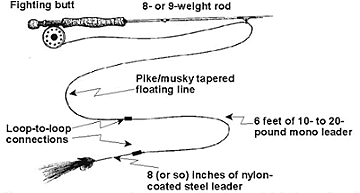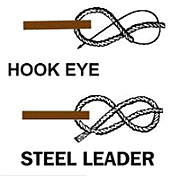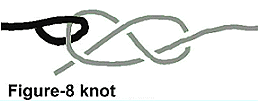Fly-fishing for Prairie Pike
Pike Equipment And Rigging Up
By Clive Schaupmeyer
This the second of a series of five articles about fly-fishing
for pike. The articles include: introduction; equipment and rigging; flies
and other gear; when and where; and techniques.

You need heavy-duty gear for pike.
An 8- or 9-weight fly rod with a fighting butt is required, even if
the pike where you fish are not very big. Heavier rigs help cast big, heavy
streamers, and the extra power helps control even a mid-sized pike when
it's buried in dense weeds. A 7-weight rod may be suitable if there's no
chance of hooking a trophy fish, but definitely leave your new 5-weight
trout rod at home, even if it has a great guarantee. Pike don't usually
make long runs, but when they go they are unstoppable, and a feisty 12-pound
pike will likely explode a light trout rod. In addition to the practical
need for heavier gear, there's an ethical demand. A moderate-sized pike
will take far too long to land with light gear, and likely be too tired
for successful release. Match your gear to the fish.
A standard weight-forward, floating line will do for pike fishing and
is what I used for several years. In 1998, I finally broke down and bought
a floating Musky/Pike Taper, and it is superior for casting heavy flies.
Normally flies attached to a floating line will naturally sink down two
or more feet, and if the pike are deeper, one or two split shot can be
added to the monofilament leader. Later in the summer, when pike are deeper
down in cooler water, a sink-tip or full sinking line may be required.
Pike put a lot of stress on reels. Their short runs are unstoppable,
and sooner or later you'll have your knuckles severely rapped by the reel
handle. This high-speed stress is hard on reel innards, so buy a moderately
priced to high-end reel with a positive drag system that will help control
hard runs. Add 50 yards or so of 20-pound test braided Dacron backing to
build up the line's diameter on the spool. This mainly is to speed up line
retrieval, for it's unlikely you'll see the backing very often when pike
fishing–but it can happen.
Four to six feet of 10- to 20-pound test, level monofilament leader
is attached to the fly line with a loop-to-loop connection or nail knot.
(Tapered leaders are neither necessary nor desirable for casting big flies).
Loop-to-loop connections make for fast leader changes on the water. I use
level monofilament, no more than six feet long, so I can manoeuver the
pike in close without worrying about the loop connection hanging up in
the top guides–which could happen with a leader longer than the rod. For
those of us who are not powerful casters, the shorter leaders also result
in better line and fly turnovers. However, some fly anglers prefer longer
leaders during the later part of the season when pike are more cautious.

There are several combinations of materials and methods to connect
flies to the end of mono leaders. Each has advantages and disadvantages,
and different anglers have their own preferences. (Like most fly-fishing
techniques, there are few right or wrong methods.)
I like to keep things simple and prefer attaching about eight inches
of nylon-coated braided steel leader to every fly I tie. The steel fly
leader is connected to the mono leader with a loop-to-loop connection.
I've never had a steel leader break; changing flies is fast; and, other
than simple end loops, no knots are used.
I've been attaching an eight-inch coated steel leader to every fly I
tie by melting the outside of the plastic-coated steel leader. It's a simple
system that has work for me for years. However, I was recently shown two
other methods. There is a new type of braided steel leader which can be
tied to the fly with a standard clinch knot. Sounds good. I was also recently
show the figure-8 knot. It looks great and I will definitely be trying
this knot this spring.

Figure-8 knot
Steel leaders occasionally kink and twist, and since they are impossible
to straighten must be replaced.
The melt method is as follows. Steel leaders are attached to flies by
threading two inches of leader through the eye and then twisting the tag
end around the main section several times. (Similar to the initial twists
on a clinch knot.) The twists are then fused together with a butane lighter
flame. The twisted loops are briefly heated until they bubble and turn
white, but not so long that they burn. A similar loop is formed at the
other end of the steel leader to attach to the mono leader–which also has
a loop. Steel leaders can also be attached to flies by crimping on metal
sleeves. The sleeves and crimping tools are available at most tackle shops.
Some pike fly anglers prefer using hard, teeth-resistant 20 - or
30 - pound monofilament leaders, and tie on flies–usually with a clinch knot–without
steel leaders. Fine. I tried this the first time I fly-fished for pike
and lost a fair-sized fish because it hit from the side and sheared the
leader. However, monofilament leaders may be an advantage in heavily fished
water where pike are leader shy.
Special pike leaders that have a section of braided steel at the fly
end are available. I found them inconvenient for changing flies, so continue
using mono leaders attached to the fly line, and steel leaders attached
to my flies. It's simple and it works.
Next week: Flies and other gear. ~ Clive Schaupmeyer
Our Man In Canada Archives
|

 April 19th, 1999
April 19th, 1999





 April 19th, 1999
April 19th, 1999




